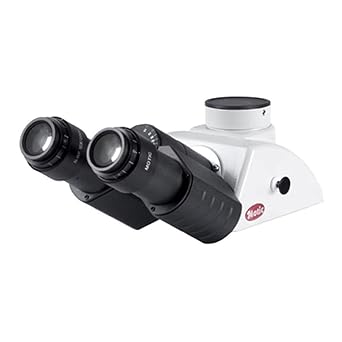
BS-2070FT (LED) Fluorescence Trinocular Compound Microscope, WF10x Eyepieces, Infinity Plan Objectives, 40x-1000x Magnification, LED Illumination, Abbe Condenser, Aperture Diaphragm, Mechanical Stage, 110V
Brand: BestScope
Out of stock
- Fluorescence microscope for performing sample analysis of biological, sedimentary rock, and semiconductor impurities
- Trinocular viewing configuration with a Siedentopf binocular head that has a pair of 20mm 10x widefield eyepieces and fixed inclination to reduce eye and neck strain, and a 30mm trinocular port that accepts a camera adapter (sold separately)
- Reverse-mounted nosepiece with 4x, 10x, 40x, and 100x (oil) infinity plan achromatic objectives for color correction, focus over the entire range of the viewing field, and a longer working distance for improved focus when auxiliary components are utilized
- Epi-fluorescence LED and lower LED illumination with rheostat and 1.25 NA Abbe condenser with aperture diaphragm for clear examination and light control
- Mechanical stage locks slide into place and provides precise slide manipulation along the X- and Y-axes, and coaxial coarse and fine focus knobs speed focusing
Description
The BestScope BS-2070FT (LED) Fluorescence Trinocular Compound Microscope has a pair of 10x widefield eyepieces, a 30mm trinocular port, a reverse-mounted nosepiece with four infinity plan achromatic objectives, LED illumination, a 1.25 NA Abbe condenser with aperture diaphragm, coaxial coarse and fine focus, and a mechanical stage. The trinocular viewing head has a Siedentopf binocular head with interpupillary adjustment, fixed inclination to reduce eye and neck strain, and 360-degree rotation capability to provide a more comprehensive view and enable sharing; and a trinocular port that accepts a camera adapter (sold separately). A Siedentopf binocular head enables the viewer to change the interpupillary distance without changing the tube length, eliminating the need to refocus the image. A reverse-mounted nosepiece keeps objectives out of the way to prevent damage and contamination, and to enable more secure slide handling. Infinity plan achromatic objectives provide color correction, focus over the entire range of the viewing field, and a longer working distance for improved focus when auxiliary components are utilized. The 100x objective is an oil objective that provides increased resolution over a standard objective. Often used in biological and metallurgical research, fluorescence microscopy uses a xenon, mercury, or LED lamp to create ultraviolet light and excitation filters to filter unwanted wavelengths, allowing users to see details undetectable to other light sources. An epi-fluorescent microscope, or incident-light fluorescent, has the lamp and excitation filter mounted above the objective. The microscope has upper (episcopic) fluorescence illumination that reflects light off the specimen for enhanced visibility of opaque specimens and provides blue and green excitation, and lower (diascopic) illumination that transmits light up through the specimen for enhanced visibility of translucent and transparent objects. The LED light sources provide bright, cool light for working with temperature-sensitive or live specimens. The lower LED has a rheostat that controls the amount of light emanating from the lamp. The Abbe condenser can be adjusted to control the distance of the light from the stage, and has an aperture diaphragm to optimize the amount of light illuminating the specimen. The mechanical stage locks the slide into place and provides precise slide manipulation along the X- and Y-axes, and can hold two slides for making comparisons between specimens. Coaxial coarse and fine focus knobs speed focusing for left-and right-handed viewers. Microscope Head and Optics SpecificationsHeadTrinocular, SiedentopfMagnification range40x-1000xTrinocular port30mmBinocular head inclination30 degreesInterpupillary adjustment48 to 75mmEyepieces (20mm)WF10xNosepieceQuadruple, reverse-mountedObjectives, infinity plan achromatic4x, 10x, 40x, 100x (oil) Microscope Illumination and Stage SpecificationsFocus typeCoaxial coarse and fineCondenser1.25 NA AbbeLight sourcesUpper: LED, 3W Lower: LED with rheostat, 3WDiaphragmApertureIllumination typeEpi-fluorescence, transmittedWavelength465 to 476nmStage typeMechanicalStage dimensions216 x 150mm (W x D)Stage travel range78 x 54mm (X-direction x Y-direction)Power110V W is width, the horizontal distance from left to right; D is depth, the horizontal distance from front to back. Microscopes are instruments used to enhance the resolution of an object or image. Types include compound, stereo, or digital. Compound microscopes use a compound optical system with an objective lens and an eyepiece. Stereo microscopes show object depth in a three-dimensional image. Digital microscopes are used to display an image on a monitor, rather than looking through a lens. Microscopes can have monocular (one), binocular (two), or trinocular (three) eyepieces, with varying magnification abilities. Magnification ability refers to the size of an image. Resolution, also known as resolvant power, refers to the clarity of the image. The interaction between field of view (FOV), numerical aperture (NA), and working distance (WD) determines resolution. Microscopes can control magnification through a fixed focus, or through a range of adjustments. They can also utilize LED, fluorescent, and mirror light sources to help control viewing capabilities. Microscopes are widely used in education, lab research, biology, metallurgy, engineering, chemistry, manufacturing, and in the medical, forensic science, and veterinary industries. BestScope International Ltd. manufactures microscopes, digital cameras, and accessories for education, inspection, research, and clinical and industrial applications. The company, founded in 1995, is headquartered in Beijing, China. What's in the Box? BestScope BS-2070FT (LED) Fluorescence Trinocular Compound Microscope (2) WF10x eyepieces, 20mm 4x infinity plan achromatic objective 10x infinity plan achromatic objective 40x infinity plan achromatic objective 100x (oil) infinity plan achromatic objective Immersion oil, fluorescent-free






